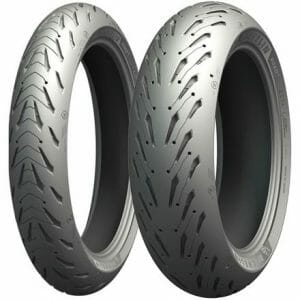Michelin Road 5: The Pinnacle of Sporty Tires
For riders with a penchant for sport or sporty bikes, the search for the perfect tire might just be over. The Michelin Road 5 is not just another tire in the market; it’s an experience waiting to be discovered.
A Successor Worth the Legacy
The Road 5 is not an unknown name in biking circles. It proudly follows the legacy of the Michelin Road 4, a tire that won accolades and riders’ trust alike. With the Road 5, Michelin hasn’t rested on its laurels. Instead, it took a tire that was already revered and elevated it to new heights.
The focus was clear: to maintain its exceptional wet grip while significantly enhancing its dry grip and stability.
Embracing Casing Technology: The Key to Superior Grip
Michelin’s unique Casing Technology (CT) is a game-changer in the tire industry. This technology ensures that the body plies remain thin across the tread face, ensuring flexibility. Yet, they are considerably thicker in the sidewalls. This combination ensures that riders experience unmatched confidence, especially during sharp cornering.
Dual Compound Mastery
The genius behind the Michelin Road 5 doesn’t stop at casing technology. Michelin has incorporated a meticulously designed compound strategy. The center of the tire boasts a wider strip of hard rubber, ensuring durability and longevity. On the other hand, the sides and shoulders of the tire house a softer compound, prioritizing grip and control.
It’s noteworthy that while the front tire benefits from the 2CT compound, the rear tire is enhanced with the 2CT Plus technology. This revolutionary design means that the tire doesn’t have three distinct rubber zones. Instead, there’s a base layer of a stiffer rubber across the entire tread face, ensuring a blend of durability and performance.
Michelin’s Mastery in Tire Design
For avid motorbike enthusiasts, the significance of a tire’s structure and design cannot be overstated. It’s not just about the rubber hitting the road; it’s about how the tire responds to varying conditions, ensuring a ride that’s both smooth and safe.
Shoulder Reinforcements for Enhanced Stability
The very anatomy of a tire can determine its performance. In the case of Michelin’s latest offering, special attention has been paid to the shoulders of the tire. These shoulders are meticulously laid in, enhancing the overall stiffness of the tire. Such a structure is pivotal in ensuring that riders experience unparalleled stability, especially when leaning into those thrilling corners. It not only offers a grip but significantly boosts the rider’s confidence in the bike’s handling capabilities.
Innovations in Grip Enhancement
But Michelin didn’t stop there. The company went a step further to elevate the grip of the tire, employing a rather ingenious approach. Instead of adding more to the tire, they chose to remove certain elements. Specifically, Michelin refined the tire’s siping. For those unfamiliar with the term, siping refers to the pattern of thin slits cut across the rubber’s surface, influencing traction.
In this innovative design, the sipes are not your regular straight columns. Instead, Michelin opted for a trapezoidal pattern. Such a design decision ensures that the tire has optimal traction, especially during challenging weather conditions, ensuring that riders have maximum control over their machine.
Michelin’s commitment to pushing boundaries in tire technology is evident in its latest designs.
Through strategic innovations and attention to detail, they ensure that riders are equipped with the best tools for the journey, no matter the destination or the path chosen.
Understanding Modern Tire Innovations
In the world of motorbiking, the significance of a reliable tire can’t be overemphasized. It plays a crucial role in the overall riding experience, ensuring safety, performance, and optimal handling. Among the myriad of tire designs available today, certain features stand out, offering riders an edge in both performance and safety.
Micro Siping: A Game Changer in Tread Technology
One such cutting-edge feature that has been capturing attention is the introduction of micro siping on the sides of the tread in some modern tires. At a glance, it might seem like a subtle design choice, but the implications of this feature are profound.
Micro siping primarily focuses on enhancing the tire’s ability to handle water. Its intricate design allows the tire to grip and disperse a larger volume of water than traditional designs. This means that in wet conditions, riders can enjoy a safer and more stable ride. The sipes, or the small cuts on the tire, are engineered to work more efficiently, channeling water away and reducing the chances of hydroplaning.
Experience Speaks Louder Than Words
While the technology and science behind tire designs can be fascinating, the true testament of a tire’s quality lies in its performance on the road. It’s one thing to read about the benefits of micro siping and another to experience its advantages firsthand.
Riders who prioritize safety without compromising on performance will find these tires to be an excellent choice. However, as with all things, it’s always recommended to put these claims to the test. After all, the road, with its unpredictability and challenges, is the best judge of a tire’s worth.
Conclusion
The realm of tire technology is ever-evolving, with manufacturers constantly pushing boundaries to enhance the riding experience. The introduction of features like micro siping showcases the industry’s commitment to innovation, marrying safety with performance. For those yet to experience the difference, the call to action is clear: Don’t just take our word for it – hit the road and feel the difference for yourself!



